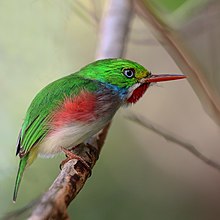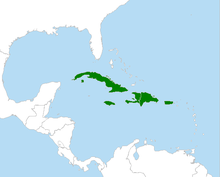Tody
| Todies Temporal range: early Oligocene – Recent |
|
|---|---|
 |
|
| Cuban tody (Todus multicolor) | |
| Scientific classification | |
| Kingdom: | Animalia |
| Phylum: | Chordata |
| Class: | Aves |
| Order: | Coraciiformes |
| Family: |
Todidae Vigors, 1825 |
| Genera | |
|
See text |
|
 |
|
| Global range (In green) | |
See text
The todies are a family, Todidae, of tiny Caribbean birds in the order Coraciiformes, which also includes the kingfishers, bee-eaters and rollers. The family has one living genus, Todus, although another genus is known from the fossil record.
The todies were originally placed in the kingfisher genus Alcedo before being placed in the genus Todus in 1760 by Mathurin Jacques Brisson. They have been linked to a large number of potential relatives since then, including nightjars, trogons, barbets, jacamars, puffbirds, kingfishers, motmots and even some passerine species such as broadbills, cotingas and flowerpeckers. It was even placed in its own order, Todiformes, before being placed in the Coraciiformes
Genetic analysis of the extant (living) species suggests that they diversified between 6-7 million years ago. The fossil record is not good for the family, but three species of tody have been described from North America, Germany and France. These fossils suggest that the family was once more widespread than it is today. Species from the fossil genus, Palaeotodus, are larger than living species and may have been closer in size to the tody motmot.
The todies are one of two bird families endemic to the islands of the Caribbean, the other being the palmchat. These are small, near passerine species of forests of the Greater Antilles: Puerto Rico, Jamaica, and Cuba, with adjacent islands, have one species each, and Hispaniola has two, the broad-billed tody in the lowlands (including Gonâve Island) and the narrow-billed tody in the highlands.
...
Wikipedia
